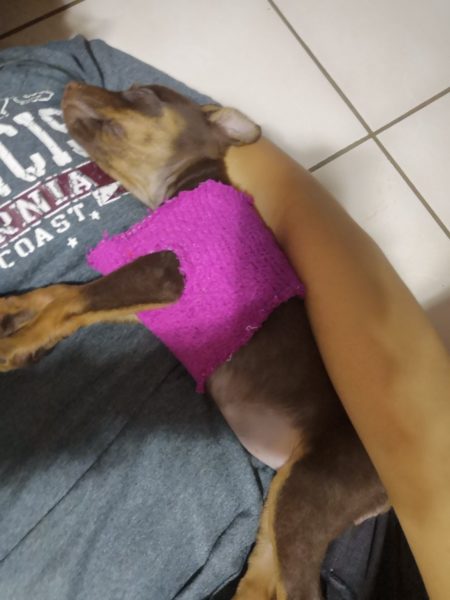The Hidden Side of Migration: Pets Left Behind

Migrants leave their families, material possesions and pets behind. Very little is said about it, but it also causes suffering.
HAVANA TIMES – It isn’t easy rushing to pack a bag because you’re no longer safe, for economic reasons or are searching for new opportunities elsewhere. You pack the essentials. Many migrants cross borders illegally wearing just a backpack with some clothes and personal items. They leave families, material possessions and even pets behind, a lot of the time.
Mocca, a coffee-colored Dobermann Pinscher, just turned eight months old. A few days before turning this age, she stopped seeing her human, a journalist who had to migrate along with her family for safety reasons and to seek study and work opportunities elsewhere.
“She was given to us when she was only three weeks old, she was tiny and I took care of her,” the journalist said, who asked to remain anonymous for her safety. “I got close to her because I was the one looking after her and she was always close to me. When I’d work, she’d sleep on my legs or on the floor. I taught her to go outside and do her bodily functions, I was the one who took her to the vet to get all of her vaccines, we bought her clothes and she learned to sleep with us.”
Now, the only way I can see Mocca is on a video call.

She said that the dog was very attached to her and that when they were together, she would come every now and again to her bedroom to check if she was there or to touch and lick her.
She wanted to take Mocca with her but her journey still hasn’t ended, as she’s only crossed Nicaragua’s southern border but still needs to make other journeys until she reaches her final destination. She looked for a way to take her as a pet, but she couldn’t, she even calculated how much it would be to take her, but it was too much and travel permits for animals vary depending on the destination country.
“When we decided to leave, I began to look up everything I needed to take her with me, I enroled her in training so I could take her but we decided to leave her in the end because it was a really long process and we didn’t have much time; plus, we’d rather settle ourselves somewhere and have our own space so we can bring her with us (later),” she explained.
Who are the pets left with?
This is a very common situation, although very little is said about it. When a person migrates and is unable to take their pet with them, they have to look for someone to stay with them. Mocca was given to a family member, along with her things: toys, treats, food, clothes, leash and collar.
“We’d rather leave her for now and not put her through all of the stress of moving around, we decided to leave her somewhere we know she’ll be looked after, loved and where she will also provide company too,” the journalist said.
Another migrant, who also asked to remain anonymous, left her two cats behind: a yellow one called Golden and a black one called Wakanda. The former was left with her mother’s friend and the second one went to a cousin until they could find her a home.
She had adopted Golden from a neighborhood where she was abused and was with her until she turned a year and a half old. Wakanda came six months later and “stole my heart”, she says.
“It really broke my heart because the cat was lovely to me, if I went to the local store, he’d come with me as if he were a dog, he would come with me to walk my cousin’s dog, he was so lovely, he ended up choosing me really as the person he wanted to protect him and give him a home rather than me choosing him as a pet,” she recalled about Wakanda.

It was impossible to take him, she said. “I couldn’t even take my belongings the day I left, I could only take a change of clothes and my cellphone, I even forgot to take the charger or anything else, it was all so fast. Out of all the things I left behind, he’s the one I miss the most.
Golden passed away recently. He was a neutered cat, “he wasn’t roamer ”, but it seems he was poisoned. “I know that Wakanda is OK, my cousin has sent me photos, he’s a spoilt little cat,” she said.

Recommendations
Mariet Ortega, from Clay Vets, pointed out that in every case, the pet’s previous experiences need to be analyzed and then the best option needs to be chosen based on this. “The adaptation process of a pet to a new home, new people, a new environment has psychological implications, there is stress, behavioral changes, but if the animal has been loved and taken care of and goes to somebody else who also loves animals, the change isn’t too hard,” she explained.
To help your pet to adapt, the vet recommends:
-Choosing the kind of person who will adopt the pet, so they don’t end up on the street or in an animal shelter. “They will need a check-up by a vet, to know whether they can be adopted or not.
-Bear in mind: the person you’re giving the pet to’s means (financial, for example), your pet’s personality, whether they get on with their new owners or not. “You need to think about whether they should go to a home where they’ve had pets or have pets now,” she explains.
-Pets will normally suffer “stress” during the adaptation process, linked to a new environment, new rules, new bacteria and even new diets, depending on the means of the person receiving them. “They can be submissive, nervous or even aggressive at times.”
-The person receiving the pet will need to find out what the pet’s personality is like and the adaptation process can take 7 days, but it could also take four or five months.
-Remember that symptoms your pet might have are: Anxiety, destroying things, crying, appetite loss, aggressiveness, withdrawal, especially among adults.
-In the case of puppies, this could be “nerves” in the first few days, vomiting and diarrhea, when they eat different foods.
For the people able to migrate with their pets, she recommends:
-Researching travel times, the routes they will take them and requirements in destination countries.
-If pets are traveling by plane, they can go in luggage. “There are places where they ask to see a check-up, vaccine and give a tranquilizer to prevent stress, which could lead to a heart attack.
-Think about whether your pet will be able to embark on such a long journey. It’s advisable for a vet to do a check-up to prevent death of the pet while traveling. “There have been cases of old dogs and cats that can’t take a journey over two hours long.”
-Even if vaccines aren’t asked for, most destination countries require pets to be fully vaccinated. Your pet’s vaccination history and health certificate.
-If the journey is long, a tranquilizer is recommended.
-You also have to factor in the size of your pet, if your pet is too big they will be separated from their owner. If the pet is small, they can travel with their owner and it will be less stressful for them.





